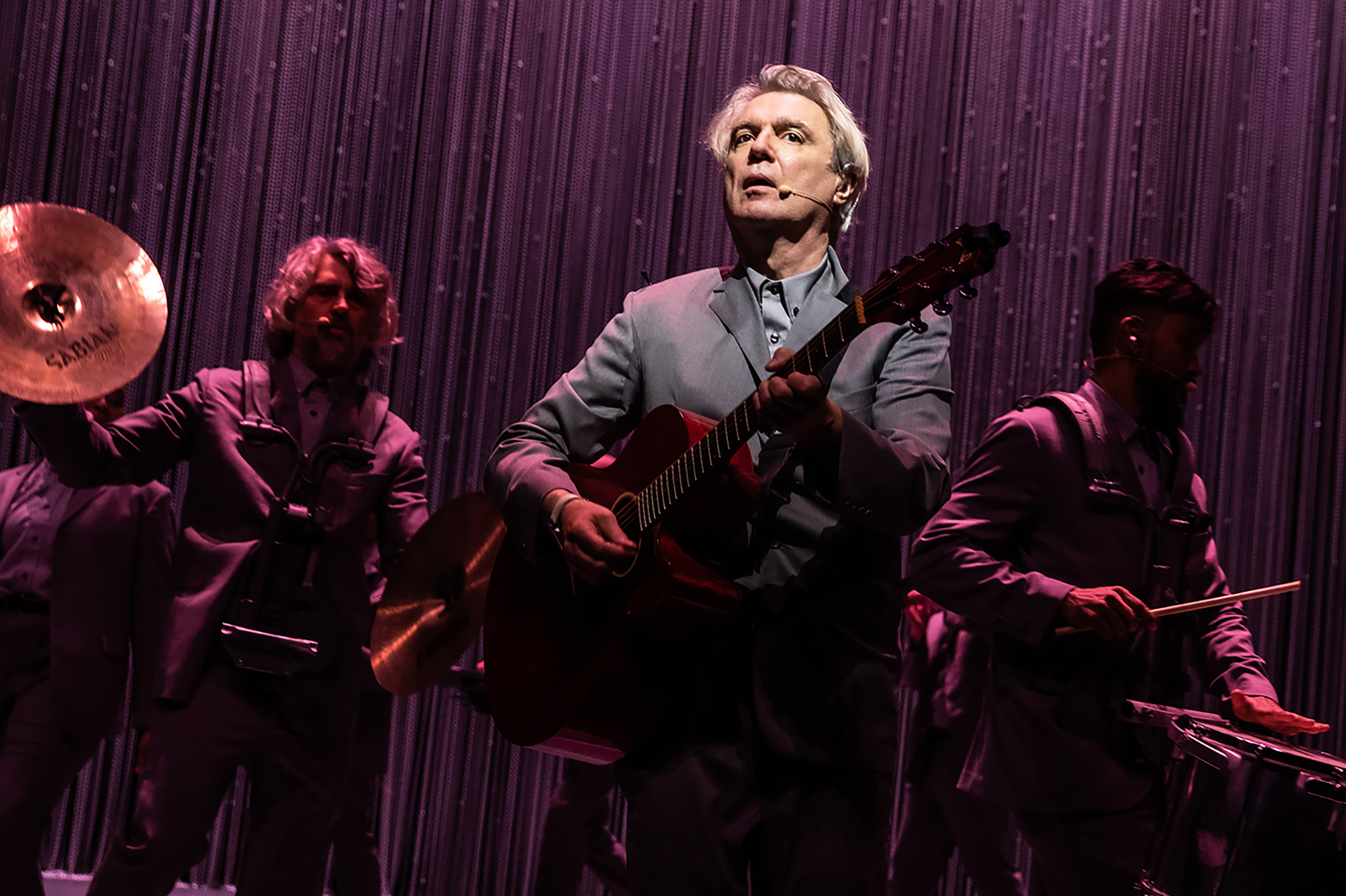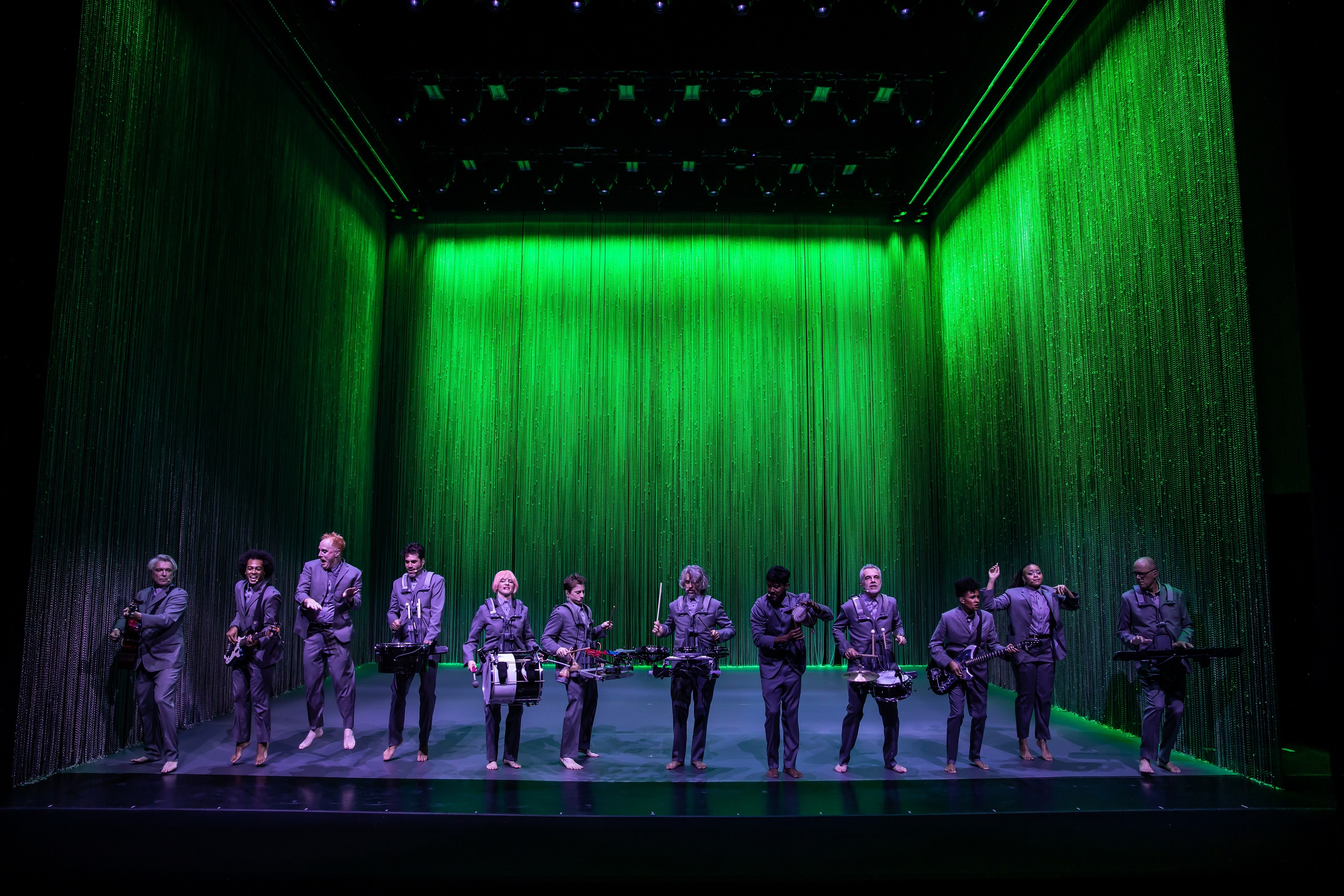Long before it was hailed by NME as “the best live show of all time,” David Byrne’s American Utopia existed just as a series of innocuous programmed drum beats sitting on Brian Eno’s hard drive. Like a jazz drummer, there were some variations here and there, but the groove maintained. During a casual get-together, Eno played the beats for his friend David Byrne, and, in that uncanny and indescribable way that it just happens, an idea was born. “Eno’s drum tracks were so energetic, and exciting sounding, I thought, ‘Man, this would be really great if you could do a live show with a bunch of marching drummers,'” Byrne explains over the phone from his New York City apartment during a short reprieve from signing limited edition copies of his forthcoming book of illustrations.
The project received its title during a moment of euphoria at a 2017 Chance The Rapper concert, which Byrne remembers as “a very positive show, a wonderful feeling in the crowd at that show,” and American Utopia dropped in March of 2018. Listeners latched on quickly, and the album debuted at No. 3 on the Billboard 200, marking the first time that Byrne’s work ever broke the Top 10. With American Utopia finally out in the world, it was time for Byrne to embark on a series of tests and experiments working toward delivering to the stage the unique vision that popped into his head that evening at Brian Eno’s house. Once Byrne and his band eventually hit the road, it wasn’t very long before Broadway producers started to take notice and express interest in bringing the show to the “proper” stage.
After the tour wrapped, Byrne immediately turned his focus to this new adventure. “I said, ‘I want to try that. If it fails, it fails, but at least I’d be trying something new instead of just sticking with exactly what I’m doing.'” He enlisted the help of choreographer Annie-B Parson and Broadway veteran Alex Timbers (Moulin Rouge, Oh, Hello! On Broadway) to restructure the set, add some more monologues, and build out a story, all whilst retraining his performing brain for a new type of show. “We’re used to judging how we’re doing by whether people get up and dance. It took a while for us to figure out, ‘Oh, they’re really listening, their heads are moving. If anything, they listen more than a concert audience listens.”
With stellar reviews and numerous awards, including a Grammy for the album and a handful of Emmys for the Spike Lee-directed film adaptation, I have to admit that I feared American Utopia couldn’t possibly live up to the hype it has generated over the last several years. I made a point to not watch the film on HBO Max, knowing full well that I should take advantage of being a New York resident and see the show live when it returned after the COVID-induced Broadway closure. After nearly two years without an indoor concert, I put on two masks and headed to the St. James Theatre, daring David Byrne and American Utopia to prove my doubts wrong.
Geez, was I proven wrong — and quickly, too. My uncertainties were remedied within the opening number, which revealed Byrne alone on the stage sitting at a table in front of a model brain. He then proceeded to detail the parts of the brain that we use to go about our everyday lives, and the parts that help us to derive joy, and I was fully sold. Running just under two hours with no intermission, the show is nothing short of a marvel, quite unlike any live music experience out there. Through the construction of American Utopia, David Byrne has mastered the art of making you feel without telling you how or what you should be feeling. It’s an absolute masterwork in musicianship, an unmatched technological feat, and an all-encompassing product of one of the most important creative minds of our time.
Our conversation with Byrne has been condensed and lightly edited for clarity.
I’d love to hear a little bit more about the intentionality behind the show’s choreography. When I was watching it, I was thinking, “Why did you move your hand in that certain way?” Or, “Why did the band spin at that time?”
It doesn’t always have a logic to it, but what we discover is that as a viewer, in our brains, we tend to connect things that happen at the same time. If somebody moves a certain way and the music’s doing this, and the words are saying this, your brain puts it all together and it tells you that somehow that movement has some connection with what’s being said. It may not have been originally conceived that way, but it ends up happening. I’m not going to say none of it makes any sense, but there’s not a super logical connection between all the movement and what the songs are saying.
I came away understanding that you were trying to illustrate the beauty of shared human experience and the ways that humans can almost thrive off the kinetic energy of others. How would you say that the pandemic changed the approach to this narrative?
The things we’re talking about, about human connection and being together with other people and stuff like that, everybody’s thinking about that now. We just went through a whole thing where we couldn’t be together and how insane that was. People had mental and psychological issues because they couldn’t be with other people. We all realized how important that is.
It seems like the version of the show that I saw was probably different than what you were performing prior to the closure. Do you consider it to be an ever-evolving piece, or are you just adapting with the times?
Kind of adapting to the times. I knew that coming back after the pandemic, it was the elephant in the room. You couldn’t ignore it, at least in a show like this. If you’re doing Lion King, you’re not going to stop in the middle and say, “Let’s talk about the pandemic. Here in the jungle…” No. But in this show, because I talk directly to the audience, like a standup comedian almost, I can address the world as it changes, which is really nice.

You’ve been doing two shows in a span of just a couple of hours on weekends. How do you keep each show interesting for yourself and the band? Do you do anything to shake it up from performance to performance?
When we’re touring of course, you’re in a different city, so it’s a completely different theater, different audience, everything like that. In this case, just the audience changes, so it’s a little more subtle. A different audience reacts differently. It’s amazing, sometimes some of the lines I say one show will get a laugh, and the next show silence. I can vary the things I say a little bit depending on how an audience is responding. If they respond a lot to one thing, I can push that a little bit further, add a line or two. If they don’t, then I just move on. So I can adapt a little bit.
This show is of course comprised of songs from throughout your career — how did you select specific songs to be included? Did you ever feel like you were fitting a square peg into a round hole to include certain songs? Or alternatively, did you uncover that your songwriting throughout your career has had these inherent thematic threads that hold the show together?
I think more the latter. I have enough of a catalog that I could choose songs that helped create a narrative thread. Of course, some of the songs are well known to the audience, some are not. The good thing for me is, yes, some of the audience reacts instantly to a song that they know, but they’re also paying attention to the other ones too. A song like “Psycho Killer” might be popular with the audience, but it doesn’t belong in the show.
It seems like a lot of your work recently has revolved around reminding people of the beauty of being alive, both with this show and Reasons To Be Cheerful. Do you feel like you have a responsibility to serve as a reminder that things aren’t really so bad?
I feel like I have a responsibility to myself. I’d feel pretty bad if I didn’t cling on to some grain of hope or possibility, whether it’s in the show or with the news stuff that we report. Yeah, I feel like I have to. There’s so much toxic stuff out there and I feel like, for my own sanity, I have to find an antidote to that.
On the other hand, though, you take some of the monologue portions of the show to emphasize, for example, the importance of voting and to remind young people like me that we’re fucked. Or even perform a rendition of Janelle Monae’s “Hell You Talmbout.” How do those aspects of the show factor into your mission of maintaining that nice things are, in fact, happening?
We started doing the Janelle song when we were doing the concert tour. I used to end my shows with a cover version of something. It was just this happy, “We all know this song. This’ll be fun.” And I thought, “We’re living in pretty dire times.” And part of our responsibility as citizens is to acknowledge what’s going on in the world and not just escape from it. And so I thought, “We have to acknowledge the reality of the world.” But then, in a certain way, we present an alternative to it.
I was reading your recent Rolling Stone interview with Lorde and you guys talked a bit about the intersection of clarity and mystery in art. I have always found myself simultaneously fascinated and frustrated with someone like, for example, David Lynch, where it’s so clear that in his head he gets what’s going on but I’m just like, “What is happening?”
[Laughs] I don’t blame you. I kind of feel the same way. Sometimes the imagery is really beautiful and mysterious, but sometimes I think this just was a cool image he had in his head and he wanted to put it in.

But I didn’t have that reaction to American Utopia, which you’ve just said yourself is a little bit more random in its visual representation. So how do you figure out how to find the middle path between clarity and mystery in art?
We don’t want to be too obvious in what we’re saying. Give the audience some credit that they can fill in the blanks and figure it out. Maybe not in an extremely literal way, but they can get it from the feeling of the song. Sometimes that understanding is hard to put into words, because it’s not literal storytelling, but I feel like that works and it gives enough wiggle room so that a listener can apply it to their own life. I also never like to be didactic about stuff, never like to tell people what to think.
Ok, I have one big final question for you. What I’ve always loved about your work is the clarity of message and your ability to stay focused on the topical north star. When you sit down to accomplish a creative task, how do you keep yourself organized and motivated to present the thesis in a way that’s both clear and understandable?
Wow. My house is messy, but my thoughts are very organized.
David Byrne’s American Utopia is back on Broadway, and tickets are available here. If you’re not in New York, you can always watch the film on HBO Max.
David Byrne is a Warner Music artist.







